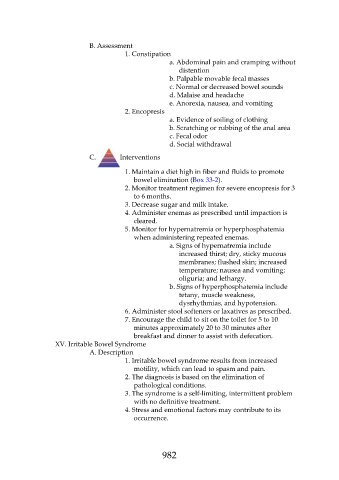Page 982 - Saunders Comprehensive Review For NCLEX-RN
P. 982
B. Assessment
1. Constipation
a. Abdominal pain and cramping without
distention
b. Palpable movable fecal masses
c. Normal or decreased bowel sounds
d. Malaise and headache
e. Anorexia, nausea, and vomiting
2. Encopresis
a. Evidence of soiling of clothing
b. Scratching or rubbing of the anal area
c. Fecal odor
d. Social withdrawal
C. Interventions
1. Maintain a diet high in fiber and fluids to promote
bowel elimination (Box 33-2).
2. Monitor treatment regimen for severe encopresis for 3
to 6 months.
3. Decrease sugar and milk intake.
4. Administer enemas as prescribed until impaction is
cleared.
5. Monitor for hypernatremia or hyperphosphatemia
when administering repeated enemas.
a. Signs of hypernatremia include
increased thirst; dry, sticky mucous
membranes; flushed skin; increased
temperature; nausea and vomiting;
oliguria; and lethargy.
b. Signs of hyperphosphatemia include
tetany, muscle weakness,
dysrhythmias, and hypotension.
6. Administer stool softeners or laxatives as prescribed.
7. Encourage the child to sit on the toilet for 5 to 10
minutes approximately 20 to 30 minutes after
breakfast and dinner to assist with defecation.
XV. Irritable Bowel Syndrome
A. Description
1. Irritable bowel syndrome results from increased
motility, which can lead to spasm and pain.
2. The diagnosis is based on the elimination of
pathological conditions.
3. The syndrome is a self-limiting, intermittent problem
with no definitive treatment.
4. Stress and emotional factors may contribute to its
occurrence.
982

